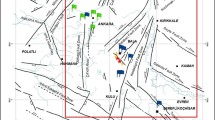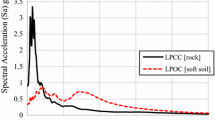Abstract
We study site effects using 520 weak motion earthquake records from a vertical array in Aegion, Greece. The array is inside a basin, has four stations in soil, and one in bedrock (178 m depth). The site is marked by high seismicity and complex surface geology. We first use the records to establish the downhole accelerometer orientations and their evolution with time. Then we estimate site effects using empirical spectral ratios with and without a reference site (standard and horizontal-to-vertical spectral ratio). We find significant site amplification which cannot be accounted for by 1D model predictions, along with a significant difference in the amplification level between the two horizontal components. These are indications of 2D effects, namely surface waves generated at the basin edge. The difference in amplification between the horizontal components is maximised when these are rotated with respect to the orientation of the basin edge. The strongest amplification takes place in the direction parallel to the basin edge (SH, or out-of-plane motion), and is up to 2 times higher than in the perpendicular direction (SV, or in-plane motion). This directional effect on the amplification is corroborated by numerical 2D modelling using incident SH and SV waves, with the former possibly generating strong Love waves. In the records, the directionality is clear for windows containing the largest amplitudes of the records (S waves and strong surface waves), while it tends to vanish for coda-wave windows. This directionality is also observed when using response spectral ratios rather than Fourier ratios. We compute soil-to-rock amplification factors for peak ground acceleration (PGA) and find it is significantly higher than what is predicted by current design codes. We attribute this difference to the basin edge amplification, linear soil behaviour, and to the inability of simple scalar values like PGA to describe complex amplification effects. Finally, we analyse the earthquake records at a surface station near the slope crest and do not observe significant topographic amplification.

















Similar content being viewed by others
References
Abrahamson NA, Silva WJ, Kamai R (2014) Summary of the ASK14 ground motion relation for active crustal regions. Earthq Spectra 30:1025–1055
Aki K (1969) Analysis of the seismic coda of local earthquakes as scattered waves. J Geophys Res 74:615–631
Aki K (1993) Local site effects on weak and strong ground motion. Tectonophysics 218:93–111
Anderson JG, Hough SE (1984) A model for the shape of the Fourier amplitude spectrum of acceleration at high frequencies. Bull Seismol Soc Am 74:1969–1993
Apostolidis P, Raptakis D, Pandi K, Manakou M, Pitilakis K (2006) Definition of subsoil structure and preliminary ground response in Aigion city (Greece) using microtremor and earthquakes. Soil Dyn Earthq Eng 26:49–67
Ashford SA, Sitar N (1997) Analysis of topographic amplification of inclined shear waves in a steep coastal bluff. Bull Seismol Soc Am 87:692–700
Bonilla L-F, Steidl JH, Gariel J-C, Archuleta RJ (2002) Borehole response studies at the Garner Valley downhole array, southern California. Bull Seismol Soc Am 92:3165–3179
Borcherdt RD (1970) Effects of local geology on ground motion near San Francisco Bay. Bull Seismol Soc Am 60:29–61
BSSC (Building Seismic Safety Council) of the National Institute of Building Sciences (2004) NEHRP Recommended provisions for seismic regulations for new buildings and other structures (FEMA450). Part 1: Provisions. 2003 edn. Washington DC
CEN (European Committee for Standardisation) (2003) Eurocode 8: Design of structures for earthquake resistance. Part 1: General rules, seismic actions and rules for buildings (EN 1998-1: 2004). Brussels, Belgium
Chávez-García FJ (2011) Site effects due to topography and to soft soil layers: progress made and pending issues. A personal perspective. In: 5th international conference of earthquake geotechnology engineering, State of the art lecture, Santiago, Chile, 10–13 Jan 2011
Chávez-García FJ, Faccioli E (2000) Complex site effects and building codes: making the leap. J Seismol 4:23–40
Chávez-García F-J, Pedotti G, Hatzfeld D, Bard P-Y (1990) An experimental study of site effects near Thessaloniki (northern Greece). Bull Seismol Soc Am 80:784–806
Di Alessandro C, Bonilla LF, Boore DM, Rovelli A, Scotti O (2012) Predominant-period site classification for response spectra prediction equations in Italy. Bull Seismol Soc Am 102:680–695
Field E (1996) Spectral amplification in a sediment filled valley exhibiting clear basin-edge induced effects. Bull Seismol Soc Am 86:991–1005
Field E, Jacob K (1995) A comparison and test of various site-response estimation techniques, including three that are not reference-site dependent. Bull Seismol Soc Am 85:1127–1143
Geli L, Bard PY, Jullien B (1988) The effect of topography on earthquake ground motion: a review and new results. Bull Seismol Soc Am 78:42–63
Goldstein P and Snoke A (2005) SAC availability for the IRIS community, incorporated institutions for seismology data management center electronic newsletter. http://www.iris.edu/news/newsletter/vol7no1/page1.htm Last accessed 20 Jun 2010
Goldstein P, Dodge D, Firpo M, Minner L (2003) SAC2000: signal processing and analysis tools for seismologists and engineers. In: Lee WHK, Kanamori H, Jennings PC, Kisslinger C (eds) Invited contribution to ‘the IASPEI international handbook of earthquake and engineering seismology’. Academic Press, London
Jongmans D, Campillo M (1993) The response of the Ubaye Valley (France) for incident SH and SV waves: comparison between measurements and modelling. Bull Seismol Soc Am 83:907–924
Kawase H (1996) The cause of damage belt in Kobe: ‘the basin effect’, constructive interference of the direct S wave with the basin induced diffracted Rayleigh waves. Seismol Res Lett 67:25–34
Kennet BLN (1983) Seismic wave propagation in stratified media. Cambridge University Press, New York 242 pp
Konno K, Ohmachi T (1998) Ground-motion characteristics estimated from spectral ratio between horizontal and vertical components of microtremor. Bull Seismol Soc Am 88:228–241
Ktenidou O-J (2010) Experimental and theoretical study of seismic ground motion in the city of Aegion, Greece, focusing on local site and topographic effects. PhD thesis, Department of Civil Engineering, Aristotle University Thessaloniki, Greece. http://invenio.lib.auth.gr/record/124050/files/GRI-2010-5489.pdf
Ktenidou O-J (2011) Estimation of the variability of kappa using a borehole array at Aegion (Gulf of Corinth, Greece). BERSSIN, IRSN. Report PRP-DGE-SCAN/2012, pp 73
Ktenidou Ο-J, Chávez-García FJ, Pitilakis Κ (2011) Variance reduction and signal-to-noise ratio: reducing uncertainty in spectral ratios. Bull Seismol Soc Am 101:619–634
Laurendeau A, Cotton F, Ktenidou O-J, Bonilla L-F, Hollender F (2013) Rock and stiff soil site amplification: dependency on Vs30 and kappa (κ0). Bull Seismol Soc Am 103:3131–3148
Lekidis VA, Karakostas CZ, Dimitriu PP, Margaris BN, Kalogeras I, Theodulidis N (1999) The Aigio (Greece) seismic sequence of June 1995: seismological, strong motion data and effects of the earthquakes on structures. J Earthq Eng 3:349–380
Lermo J, Chávez-García F-J (1993) Site effect evaluation using spectral ratios with only one station. Bull Seismol Soc Am 83:1574–1594
Matsushima S, Hirokawa T, De Martin F, Kawase H, Sanchez-Sesma FJ (2014) The effect of lateral heterogeneity on H/V spectral ratio of microtremors inferred from observation and synthetics. Bull Seismol Soc Am 104:381–393
Molkenthin C, Scherbaum F, Griewank A, Kuehn NM, Stafford P (2014) A study of the sensitivity of response spectral amplitudes on seismological parameters using algorithmic differentiation. Bull Seismol Soc Am 104:2240–2252
Moretti I, Sakellariou D, Lykousis V, Micarelli L (2003) The Gulf of Corinth: An active half graben? J Geodyn 36:323–340
Papazachos BC, Papazachou CB (2003) Earthquakes of Greece (in Greek). Ziti Editions, Thessaloniki
Parolai S, Bindi D, Augliera P (2000) Application of the generalized inversion technique (GIT) to a microzonation study; numerical simulations and comparison with different site-estimation techniques. Bull Seismol Soc Am 90:286–297
Parolai S, Ansal A, Kurtulus A, Strollo A, Wang R, Zschau J (2009) The Atakoy vertical array (Turkey): insights into seismic wave propagation in the shallow-most crustal layers by waveform deconvolution. Geophys J Int 178:1649–1662
Phillips SW, Aki K (1986) Site amplification of coda waves from local earthquakes in central California. Bull Seismol Soc Am 76:627–648
Pitilakis K, Makropoulos K, Bernard P, Lemeiile F, Lyon-Caen H, Berge-Thierry C, Tika Th, Manakou M, Diagourtas D, Raptakis D, Kallioglou P, Makra K, Pitilakis D, Bonilla F (2004) The Corinth gulf soft soil array (CORSSA) to study site effects. C R Geosci 336:353–365
Pitilakis K, Riga E, Anastasiadis A (2012) Design spectra and amplification factors for Eurocode 8. Bull Earthq Eng 10:1377–1400
Raptakis D, Chávez-García FJ, Makra K, Pitilakis K (2000) Site effects at Euroseistest—I. Determination of the valley structure and confrontation of observations with 1D analysis. Soil Dyn Earthq Eng 19:1–22
Raptakis D, Makra K, Anastasiadis A, Pitilakis K (2004a) Complex site effects in Thessaloniki (Greece). I. Soil structure and confrontation of observations with 1D analysis. Bull Earthq Eng 2:271–300
Raptakis D, Makra K, Anastasiadis A, Pitilakis K (2004b) Complex site effects in Thessaloniki (Greece): II. 2D SH modelling and engineering insights. Bull Earthq Eng 2:301–327
Rodriguez Marek A, Cotton F, Abrahamson NA, Akkar S, Al Atik L, Edwards B, Montalva GA, Dawood HM (2013) A model for single-station standard deviation using data from various tectonic regions. Bull Seismol Soc Am 103:3149–3163
Rosenblueth E, Arciniega A (1992) Response spectral ratios. Earthq Eng Struct Dyn 21:483–492
Şafak E (1997) Models and methods to characterize site amplification from a pair of records. Earthq Spectra 13:97–139
Şafak E (2001) Local site effects and dynamic soil behavior. Soil Dyn Earthq Eng 21:453–458
Steidl JH, Tumarkin AG, Archuleta RJ (1996) What is a reference site? Bull Seismol Soc Am 86:1733–1748
Theodulidis N, Bard P-Y, Archuleta R, Bouchon M (1996) Horizontal-to-vertical spectral ratio and geological conditions: the case of Garner Valley downhole array in southern California. Bull Seismol Soc Am 86:306–319
Thompson EM, Baise LG, Kayen RE, Guzina BB (2009) Impediments to predicting site response: seismic property estimation and modeling simplifications. Bull Seismol Soc Am 99:2927–2949
Wen K-L, Beresnev IA, Yeh YT (1994) Nonlinear soil amplification inferred from downhole strong seismic motion data. Geophys Res Lett 21:2625–2628
Wessel P, Smith WHF (1998) New, improved version of the generic mapping tools released. EOS Trans AGU 79:579
Yamazaki F, Lu L, Katayama T (1992) Orientation error estimation of buried seismographs in array observation. Earthq Eng Struct Dyn 21:679–694
Zhao JX, Zhang J, Asano A, Ohno Y, Oouchi T, Takahashi T, Ogawa H, Irikura K, Thio HK, Somerville PG, Fukushima Y, Fukushima Y (2006) Attenuation relations of strong ground motion in Japan using site classification based on predominant period. Bull Seismol Soc Am 96:898–913
Acknowledgments
M. Lancieri (Institut de Radioprotection et de Sûreté Nucléaire - IRSN) provided valuable guidance in signal analysis and catalogue improvement. We thank S. Arnaouti, P.-Y. Bard, D. Bindi, F. Bonilla, D. Boore, F. Cotton, H. Kawase, A. Kiratzi, A. Laurendeau, M. Manakou, Z. Roumelioti, S. Specht for helpful discussions. Special thanks go to S. Parolai and E. Riga. The suggestions of two anonymous reviewers helped improve and enrich the manuscript. The research was partly funded by European research Projects LESSLOSS, 3HAZ, and NEMISREF, French Projects ANR DEBATE and SIGMA, and the Propondis Foundation. F. J. C. G. thanks Coordinación de la Investigación Científica, UNAM, for support. Signal processing benefitted from SAC2008 (Goldstein et al. 2003; Goldstein and Snoke 2005). Some plots were made using Generic Mapping Tools v.3.4 (Wessel and Smith 1998). The CORSSA array was funded by European research project CORSEIS and the CORSSA agreement between Aristotle University of Thessaloniki (AUTH), Greece; National Kapodistrian University of Athens (NKUA), Greece; and IRSN, France. Records from CORSSA were made available through the CORSSA agreement. Records from DIM were provided by K. Makropoulos. The earthquake catalogues used are: AUTH, http://geophysics.geo.auth.gr/ss/CATALOGS/preliminary/finalcat.cat (last accessed 12/2011); NKUA, http://www.geophysics.geol.uoa.gr/catalog/catgr_20002008.epi (last accessed 12/2011); National Observatory of Athens, http://www.gein.noa.gr/services/cat.html (last accessed: 12/2011); Patras Seismological Laboratory, http://seismo.geology.upatras.gr/ (last accessed 12/2011).
Author information
Authors and Affiliations
Corresponding author
Rights and permissions
About this article
Cite this article
Ktenidou, OJ., Chávez-García, FJ., Raptakis, D. et al. Directional dependence of site effects observed near a basin edge at Aegion, Greece. Bull Earthquake Eng 14, 623–645 (2016). https://doi.org/10.1007/s10518-015-9843-x
Received:
Accepted:
Published:
Issue Date:
DOI: https://doi.org/10.1007/s10518-015-9843-x




